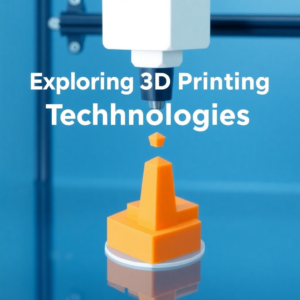Essential Tips for Choosing the Best 3D Printing Software for Your Needs

3D printing has transformed industries by offering cost-effective and innovative solutions for prototyping, manufacturing, and design. However, selecting the right 3D printing software is critical to achieving successful results. With numerous options available, it can be overwhelming to determine which one suits your specific needs. This guide outlines essential tips to help you choose the best 3D printing software, ensuring your projects run smoothly and efficiently.
Understanding 3D Printing Software Categories
Before choosing software, it’s essential to understand its primary categories. Each category serves a unique function in the 3D printing process, and the right combination can enhance workflow efficiency.
1. CAD Software (Computer-Aided Design)
CAD software is used for creating and editing 3D models. Popular choices include AutoCAD, Fusion 360, and TinkerCAD. Features to look for:
-
Intuitive interface for beginners.
-
Advanced modeling tools for professionals.
-
Compatibility with your 3D printer.
2. Slicer Software
Slicer software prepares 3D models for printing by converting them into layers and generating G-code for the printer. Key considerations include:
-
Support for multiple file formats (e.g., STL, OBJ).
-
Adjustable print settings like layer height and infill density.
-
Pre-configured profiles for popular 3D printers.
3. Firmware and Printer Control Software
Firmware bridges the gap between the slicer and the printer hardware. Printer control software like OctoPrint allows for remote monitoring and management. Features to evaluate:
-
Real-time monitoring capabilities.
-
Support for firmware updates.
-
User-friendly interface.
Factors to Consider When Choosing 3D Printing Software
1. Compatibility with Your Printer
Not all software works seamlessly with every 3D printer. Before making a choice:
-
Verify compatibility with your printer model.
-
Check if the software supports your printer’s firmware (e.g., Marlin, Klipper).
-
Ensure the file formats align with your printer’s requirements.
2. Ease of Use
Software usability is vital, especially for beginners. Look for:
-
An intuitive user interface with guided workflows.
-
Tutorials and community support.
-
Pre-designed templates or libraries for quick setup.
3. Features and Customization
Advanced features can significantly impact your printing results. Consider:
-
Ability to tweak advanced settings like support structures and retraction.
-
Compatibility with plug-ins or extensions.
-
Tools for repairing or optimizing 3D models.
4. Cost and Licensing
3D printing software ranges from free open-source options to premium subscriptions. Evaluate:
-
Budget constraints and subscription models.
-
Free trial options for paid software.
-
Long-term updates and support.
5. Community and Technical Support
Strong community and manufacturer support can help resolve challenges. Look for:
-
Active forums or user communities.
-
Availability of video tutorials and guides.
-
Responsive customer support for premium software.
Comparing Popular 3D Printing Software in 2024
1. Fusion 360
-
Category: CAD
-
Best For: Professionals seeking robust modeling tools.
-
Key Features: Parametric modeling, cloud collaboration.
-
Pricing: Subscription-based with a free version for personal use.
2. Ultimaker Cura
-
Category: Slicer
-
Best For: Beginners and experienced users.
-
Key Features: Pre-configured printer profiles, intuitive interface.
-
Pricing: Free and open-source.
3. PrusaSlicer
-
Category: Slicer
-
Best For: Advanced users.
-
Key Features: Multi-material support, detailed customizations.
-
Pricing: Free.
4. OctoPrint
-
Category: Printer Control
-
Best For: Remote monitoring.
-
Key Features: Plugin support, real-time control.
-
Pricing: Free and open-source.
5. Blender
-
Category: CAD and Animation
-
Best For: Designers seeking advanced tools.
-
Key Features: Sculpting, rendering, and model repair.
-
Pricing: Free and open-source.
Tips for Beginners
If you are new to 3D printing, consider the following tips to simplify your software selection:
Start with Free Tools
Free software like TinkerCAD or Ultimaker Cura offers excellent starting points. They provide enough functionality to understand the basics without overwhelming you.
Experiment with Pre-Configured Settings
Use default printer profiles and settings to minimize errors during initial attempts.
Leverage Online Resources
Explore tutorials, forums, and video guides to familiarize yourself with the software.
Advanced Tips for Professionals
Optimize Workflow with Integration
Using multiple software tools in a seamless workflow can boost productivity. For example, designing models in Fusion 360 and slicing them in PrusaSlicer ensures precision and flexibility.
Explore Automation Features
Many slicer tools now include automation for repetitive tasks, such as adding supports or optimizing infill patterns.
Keep Software Updated
Regular updates ensure compatibility with the latest printer models and incorporate bug fixes or new features.
Advanced Features to Look For in 2024
Cloud-Based Collaboration
Modern CAD software like Fusion 360 allows multiple users to collaborate in real time, which is ideal for team projects.
AI-Powered Tools
Some slicers now feature AI-driven suggestions for optimizing support placement and minimizing material waste.
Multi-Material and Multi-Color Support
Advanced slicers like PrusaSlicer accommodate complex designs involving multiple materials or colors, broadening creative possibilities.
FAQs: Essential Tips for 3D Printing Software
1. What is the easiest 3D printing software for beginners?
TinkerCAD and Ultimaker Cura are highly recommended for their intuitive interfaces and beginner-friendly features.
2. Can I use multiple software tools for one project?
Yes, combining CAD, slicer, and printer control software can improve results and optimize workflow.
3. Is free 3D printing software reliable?
Many free tools, such as Cura and Blender, are open-source and widely supported by the 3D printing community, making them reliable choices.
4. How often should I update my software?
It is advisable to check for updates monthly to ensure compatibility and access the latest features.
5. What features should I prioritize in slicer software?
Focus on support for multiple file formats, customizable print settings, and compatibility with your printer.
Choosing the best 3D printing software requires careful consideration of your needs, printer compatibility, and budget. By evaluating essential factors like ease of use, features, and support, you can select software that enhances your 3D printing experience. Whether you are a beginner or a seasoned professional, the right tools will streamline your workflow and help you achieve outstanding results. Stay informed with the latest updates in 2024, and make an informed decision that suits your 3D printing projects.
Visit our other website: https://synergypublish.com





